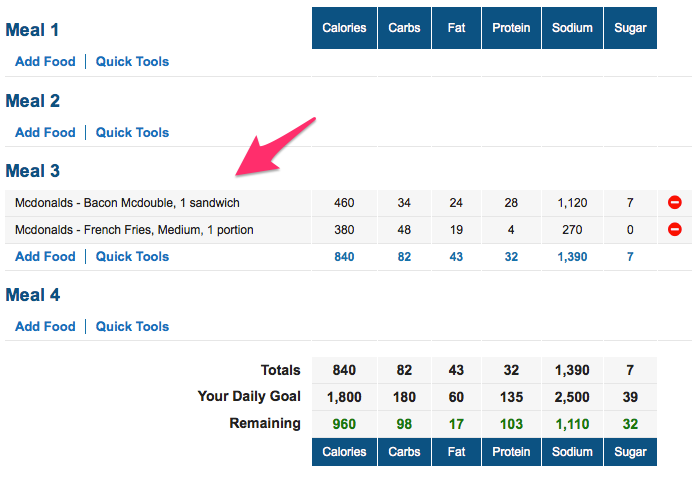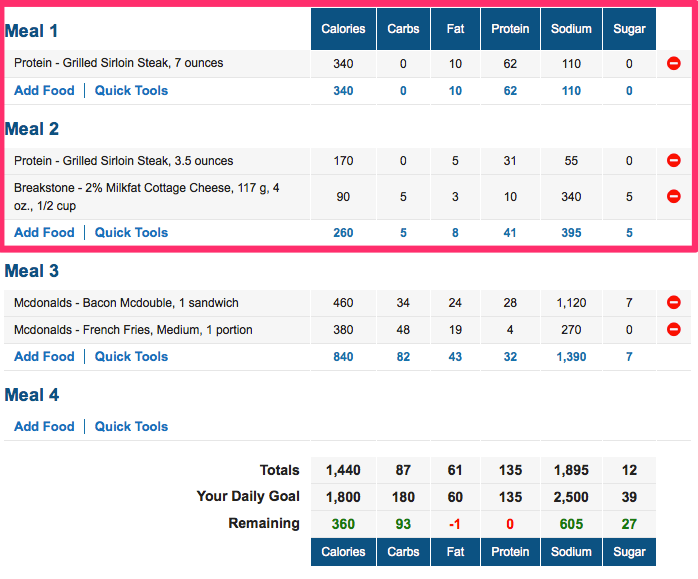This is for people who:
- Travel often.
- Spend a lot of time eating out.
Most people would automatically just tell you to eat out less frequently and start cooking more.
We both know that’s not the best solution.
I have clients, for example, that travel for work and rarely have the time to cook a single meal.
Also, if you’re a foodie like me, your taste buds simply just enjoy the variety of foods they get from eating at different places from time to time.
With some simple strategies, it’s possible to stay in shape with this type of lifestyle.
How to Eat At Restaurants or Fast Food Chains Without Putting On the Weight
Luckily for you, most restaurant and fast food chains nowadays have their nutritional info readily available.
Step #1: Look up the nutrition facts and log your food before going out to eat
This will allow you to see the numbers of what you are about to consume as well as your “remaining balance” in terms of your calorie requirements. If you don’t have access to the nutritional info, skip to the next section.
An example: Fred is a consultant that travels on a regular basis for work. He has a daily allotment of 1,800 calories to maintain his weight. Fred has a long, busy day of meetings ahead and knowing that McDonald’s is the only place near his hotel for dinner he tracks this ahead of time.

After figuring out what he wants to eat, he enters it in his MyFitnessPal. Boom. Fred instantly sees that the meal is roughly 840 calories, leaving him with 960 more for the day.
Step #2: “Budget” your calories throughout the day and prioritize protein and fibrous veggies.
Now the next step is to make sure that you save your calories. This means two things:
- Reduce your calorie intake for the day
- Eat mainly protein-dense foods + fibrous veggies
The reduction in your calorie intake is pretty self-explanatory. The high protein meal and fibrous veggie combo is to keep you full for most of the day, and for appetite suppression. Aim for a lean protein such as chicken, steak, beef, pork, cottage cheese, etc.

Another reason for the high protein meals is simply because we are trying to limit carb and fat intake. There will be plenty of that later as most foods from restaurants and fast foods chains are already high in carbs and fat.
Step #3: Enjoy your food (and maybe even drinks), guilt-free
Yep, that’s the third step. That’s all there is to it really.
In the example we have, Fred can see ahead of time that he’ll be left with 360 discretionary calories after his meals were accounted for. That’s a drink or two, or dessert he can have, totally guilt-free.
As long as he doesn’t go over his limit of 1,800 calories, Fred won’t even come close to gaining an ounce of fat. In fact, if he manages to stay in a caloric deficit for the day, he’ll actually be keeping his body in fat-burning mode.
What If There’s No Nutritional Information Available?
So now the question is, what do you do when there’s no nutritional value available? You know, when you travel somewhere and go to a mom-and-pop type of restaurant.
For these types of situations, you actually won’t track your food. At all. Unless you’re doing a bodybuilding competition, there is no need for you to track every single thing you eat while on vacation.
Follow these guidelines instead…
Bring on-the-go protein snacks with you. Protein bars and beef jerky are my favorites. They don’t take up much space in your luggage, and they’re very convenient to eat while traveling. (But do keep an eye on nuts. They’re high in protein, but they’re also high in fat, meaning that the calories add up a lot faster with every bite).
When going out to eat, pick out a meal that’s relatively high in protein. As usual, you’ll want to eat something that’s
centered around a protein source. If you’re at a Mexican restaurant, you’d get tacos instead of a quesadilla. If you’re at an Italian Restaurant, you’d get chicken beef lasagna instead of spaghetti. If you’re at a Mediterranean restaurant, get a shish kebab instead of a falafel plate.
Lastly, if possible, double up on the protein by asking for extra meat.
For meals that come with a side, ask for veggies. Restaurants usually give you multiple choices for sides. When in doubt, ask for veggies. If you recall, these are “free” calories that don’t get added up to your daily limit.
Eat until you’re full. Most restaurants serve pretty decent- sized meals. If you find yourself getting full after eating 80% of your plate, then ask for a carry-out box and finish the left-over food later. You’ll save yourself some calories just by doing this.
If you’re on vacation, eat whatever you want; just be mindful of what and how you’re eating. Just because you’re
on vacation doesn’t mean that you should start bingeing and going on a “see-food” diet. Apply the six SIMPLE guidelines as well as the ones in this section.